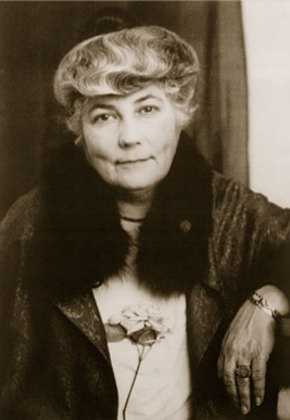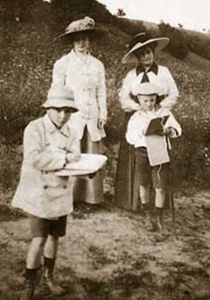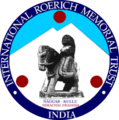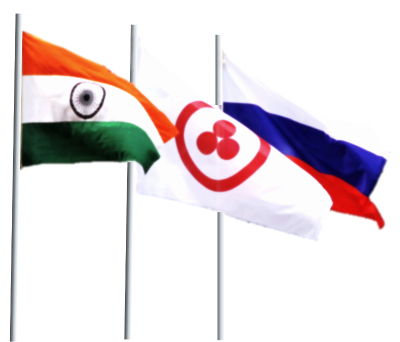In 1899, at her aunt’s, Princess Y. Putyatina, estate, Helena Shaposhnikova first met the young painter N. Roerich, who not only became her husband, but also her associate, with whom she shared the same ideas. Unity of views, spiritual proximity and deep reciprocal feelings made this union extraordinarily strong. Already in the later days of his life Nicholas Roerich wrote about his marriage: “Together we were overcoming all kinds of encumbrances. And obstacles were turning into capacities. I dedicated my books to Helena, my wife, friendess, companion, inspirer" [1, p.460]. “Friendess” – “druginya” – is an ancient Russian word that very precisely corresponded to Helena Roerich’s spirit and character. Many of N. Roerich’s paintings were the result of their common creative work, it was, as matter of fact, a “co-creativity”, in which Helena Roerich was the inspiring source. As Nicholas Roerich wrote: “We were creating together, and not in vain it was said that the created pieces should bear two names – a woman’s and a man’s” [2, p.460].
From 1924 to 1928, Helena Roerich participated in a grandiose expedition organized by N. Roerich across the hardly approachable and little explored regions of Central Asia. She was the only woman who completed this extremely difficult itinerary. Helena Roerich shared all hardships and dangers of the way with the rest of the expedition members. Nicholas Roerich wrote, “To offer help, cheer up, explain something without sparing herself – Helena Roerich is ready for anything… Often you cannot help being amazed from where her energy comes, especially knowing her weak heart <…> On horseback together with us, Helena Roerich passed whole Asia, she was frozen and starved in Tibet, but she was always the first to show an example of vigor to the whole caravan. And the more was the danger, the more vigorous, ready, and cheerful she was. She had pulse 140, but she still tried to personally participate in the caravan arrangements and settlement of all the route concerns. Nobody ever saw her in depression or despair, though there were enough of all kinds of reasons for that” [6, p.162].
1 N. Roerich. Diary Leaves. – М.: ICR, 1995. – V. 2. – p. 460.
2 Ibid.
3 Unforgettable Image. S. Roerich’s archive.
4 L. Shaposhnikova. “Let Me Get Down From The Pedestal…”: Five letters of H. Roerich // Talks with the Teacher: Selected Letters
of H. Roerich. – Riga: Fiery World, 2001. – p. 246.
5 H. Roerich. Letters. – М.: ICR, 1999. – V. 1. – p. 386.
6 N. Roerich. Diary Leaves. – М.: ICR, 2000. – V. 2. – p. 162.
7 R. Rudzitis. Meetings with George Roerich. – Minsk: Lotats, 2002. – p. 63.




In 1929, in Paris, under the pseudonym J. Saint Hilaire, H. Roerich’s study “On Eastern Crossroads” was published. Those compositions (or apocrypha, i.e. texts which had not been included in canonic scriptures) convey information of legendary and historical events of days long past, tell about unknown sides of life of the Great Teachers of humanity – Buddha, Christ, Apollonius of Tian, Sergius of Radonega. To the image of Sergius, Protector and Defender of the Russian land, Helena Roerich dedicated a separate study, in which a perfect knowledge of history and theology was combined with a deep and reverent love for the ascetic.
Perfect mastery of foreign languages and deep knowledge of philosophy allowed H. Roerich to translate into Russian the “Secret Doctrine” – an outstanding work by Helena Blavatskaya, the founder of Theosophical Society, and selected letters of Mahatmas (“The Chalice of the East”). This allowed Russian-language readers to become acquainted with such important theosophical studies.
Helena Ivanovna Roerich (1879 – 1955)
The truly great is always seen from a distance. As regards the Russian philosopher and writer Helena Roerich’s creative heritage, this was exactly the case. Much of what was created by this outstanding woman in the first half of the XX century entered the cultural and spiritual life of Russia comparatively recently, and aroused deep and sincere interest from many of our compatriots, who were trying to find answers to urgent questions concerning existence.
Helena Roerich was born on the 12th of February 1879 in Saint Petersburg, in the family of the architect-academician Ivan Shaposhnikov and his wife Ekatherina Vasilevna, whose maiden name had been Golenischeva-Kutuzova and who was the grand-niece of the great Field-Marshall Kutuzov. Through her maternal line, Helena was a distant relative of the outstanding Russian composer M. Mussorgsky.
From a very early age, the girl displayed outstanding abilities and, by the age of seven, she could read and write in three languages. Still very young, Helena took serious interest in literature and philosophy. After graduating from the Mariinsky Gymnasium and receiving a musical education, a brilliant pianist career awaited her, but life decided differently.
Having found themselves cut off from their Motherland by the revolutionary events of 1917, the Roerichs left for England. There in London, in 1920, H. Roerich started writing down the first lines of the Living Ethics – a new philosophic system representing a modern integral concept of real Cosmos. The Living Ethics books were being created by H. Roerich in close collaboration with a group of anonymous philosophers who are usually called Mahatmas (Great Souls) or Rishis (Teachers) in the spiritual tradition of India.
In the autumn of 1920, together with her husband and children, H. Roerich left for New York, where Nicholas Roerich had planned a series of exhibitions in several USA cities.
In America, under N. Roerich’s leadership and with H. Roerich’s direct participation, a small group of their associates launched large-scale cultural and educational activities. The results of their activities were striking: the creation of the “Roerich Museum”, of the “Master Institute of United Arts” and of the international artistic center “Corona Mundi”. These institutions, organized by Nicholas and Helena Roerich, turned into major cultural centers, the influence of which spread far beyond the country’s borders and becoming international. Numerous societies, creative clubs and educational institutions, offering their services all over the world under the aegis of these organizations, united under the common dome of Culture, not only creative people, but also all those who strove for the implementation of humanistic ideals and improvement of life conditions. “It fills you with joy,” Helena Roerich wrote, “to see how, in the days of destruction, luminous souls come together in the name of Culture, trying to preserve the fire and give the happiness of creativity and expansion of consciousness to those who are seeking for a way out of the formed intellectual deadlock, which is also entailing material disaster” [5, p.386].
These words “were creating together” contain great meaning. Many canvases of the artist that expressed the ideas of the Living Ethics were created according to Helena Roerich’s conceptions and on the basis of her visions.
In August of 1902, their son Yuri was born: a future world-renowned scientist and orientalist. In October 1904, Svetoslav was born: a future artist, thinker and public figure.
N. Roerich called Helena Roerich “She Who Leads” in his creations. At the same time, she was a person of amazing modesty. Having entered the life of a famous artist, she always kept in the shadow. Most of her works were published under pseudonyms. “<…> let me get down from the pedestal erected by your beautiful, loving heart <…> I like simplicity in everything, and any pomposity and solemnity are organically intolerable for me. I don’t like to teach, but just to pass knowledge” [4, p.246], she wrote in one of the letters to her friend.

In 1926, in Mongolia (Ulan Bator), where the expedition found itself at that time, H. Roerich’s manuscript “Foundations of Buddhism” was published. That book interpreted fundamental philosophic notions of Buddha’s teaching, such as reincarnation, the laws of Karma, Nirvana and also discussed the deep underlying moral principles of such teachings, which refuted one of the main stereotypes of Western thought, which believed that in Buddhism man was worthless and as a creature forsaken by God.
In 1927, still there, in Mongolia, one of the Living Ethics book – “Community” was released.
In 1928, after their return from the Central-Asian expedition, the Roerichs settled down in the ancient and picturesque valley of Kullu in the Western Himalayas. There they founded the Himalayan Research Institute “Urusvati” (“The Morning Star”). H. Roerich was elected the honorable President of this unique scientific institution and took most active part in its activities-organization. Here in Kullu, Helena Roerich once again dedicated herself to the main work of her life – the books of the Living Ethics – and continued this work till the end of her life. As a philosophy of cosmic reality, the Living Ethics contains a unique system of cognition based on general and partial laws of the Cosmos, an integral part of which are Earth and mankind. This Living Ethics system of cognition corresponds to the new evolutionary turn in the development of mankind, when the perception of the cosmic world comes to substitute scientific thinking. The name of this very philosophy – the Living Ethics – unites man and Cosmos into a single spiritual system.
A special place in Helena Roerich’s heritage occupy her letters to those who were studying the Living Ethics. If the Living Ethics teaching was created by Helena Roerich in collaboration with the Teachers, the “Letters” present a brilliant sample of her individual creative work. Gifted with an enlightener's talents, using simple and easily understandable language, she explained to her correspondents the most complicated issues of being. Including those concerning the place and role of man in the Universe, the laws of interaction between man and cosmos, and the peculiarities of relationship between spirit and matter. She gave real and practical advice. Reading those letters, one cannot help being amazed not only at her profound knowledge of ancient philosophical teachings, of the works of Oriental and European thinkers, but also at her broad and clear understanding of the foundations of existence. That is why H. Roerich’s “Letters” make necessary and integral part of the Living Ethics itself.
In January 1948, shortly after her husband’s death, Helena Roerich, together with Yuri Roerich, left the Kullu valley, and, after a short stay in Delhi and Khandala, settled in a little resort city of Kalimpong on the Eastern Himalayan slopes.
H. Roerich always yearned to come back to Russia. The applications concerning her return to the Motherland she submitted to the Soviet Embassy remained unanswered. The same happened to the letters and petitions addressed to the government. The Academy of Arts was equally unhelpful. But despite all refusals, Helena Roerich hoped to come back, to bring along all the treasures she had collected and to work at least for a few years for the Best Country – this is how she called Russia. Her hope to see Russia did not abandon her upuntil her very last days: “It cannot be that I should not come. I must come!” – she repeated just before her final departure [7, p.63]. But this return never happened. The country refused entry to her great daughter. On October 5th 1955, Helena Roerich passed away.
H. Roerich during the Central-Asian expedition
S. Roerich. Portrait of Helena Roerich. 1937
The more time passes, and the deeper we penetrate into the spiritual and philosophical heritage of the great Russian philosopher Helena Roerich, the more obvious becomes the greatness of what she has done for the evolution of the planet and for the whole mankind.
Text and photo from en.icr.su
Helena Roerich (on the right), George and Svetoslav Roerichs. Bologoye, 1913
H. Roerich was the heart, preceptress and the most important pillar of the Roerich family. Nicholas Roerich, Yuri Roerich and Svetoslav Roerich highly appreciated the role of Helena Roerich as the bright genius of the family. In his memories, S. Roerich noted: “For us and all who came into close contact with her, this spiritual communication was kind of a live assertion of the highest verities of the ever-lasting truth. Her life was shining like a live luminaire, establishing with its example the existence of a beautiful world, comprehension of which will lead the humanity to new achievements, new discoveries” [3].

N. Roerich. She Who Leads. From the "His Country" Series. 1924
The two-volume edition of “Helena Roerich’s Letters” was first published in Riga in 1940, and has been many times reissued since then. At present Helena Roerich’s letters complete collection (Volumes I-IX) was published by the Manuscript Department of International Center of the Roerichs in 1999–2009. This publication includes part of a correspondence never published before, which enables us to appreciate in an absolutely new way this outstanding woman’s participation in the movement for the Banner of Peace related to Roerich’s Pact. One can say in all confidence that signing the Pact would have been impossible without Helena Roerich. It was Helena who, during N. Roerich’s Manchurian expedition (1934–1935), maintained all the business correspondence with the international cultural and educational organizations and coordinated their activities. The result of her dedicated work was the signing of Roerich’s Pact by the heads of twenty-two countries, including the USA, on April 15, 1935.










